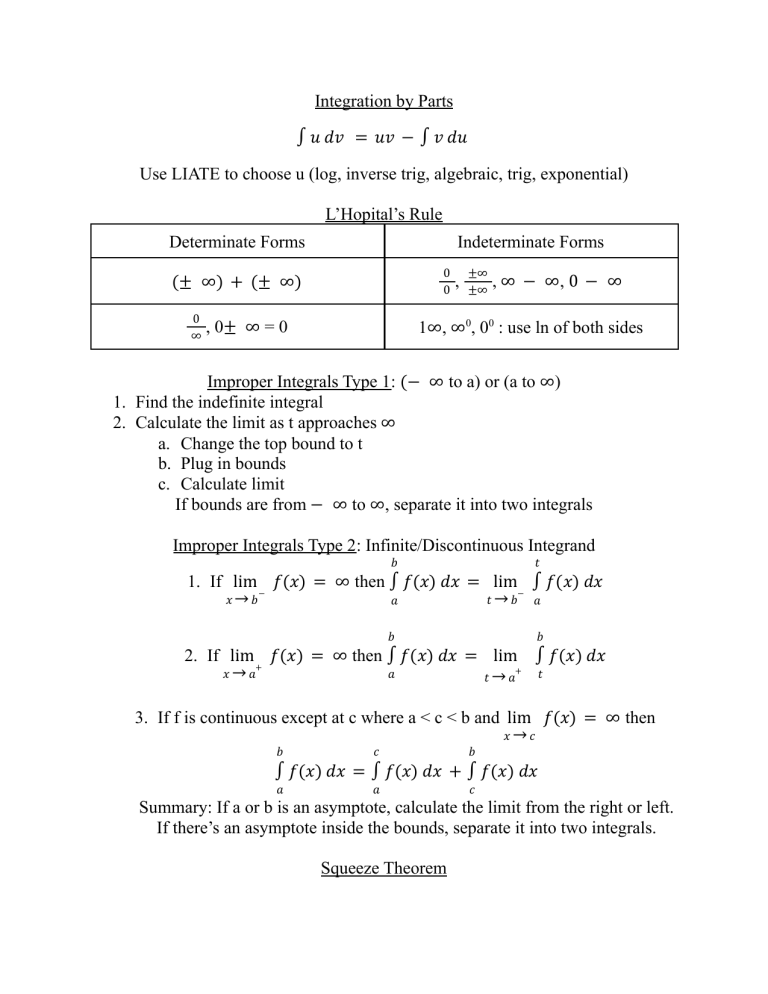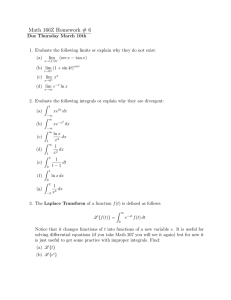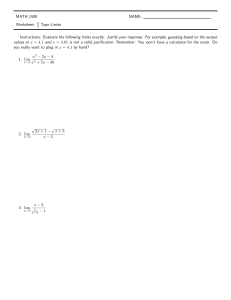
Integration by Parts ∫ 𝑢 𝑑𝑣 = 𝑢𝑣 − ∫ 𝑣 𝑑𝑢 Use LIATE to choose u (log, inverse trig, algebraic, trig, exponential) L’Hopital’s Rule Determinate Forms Indeterminate Forms 0 0 (± ∞) + (± ∞) 0 ∞ , 0± ∞ = 0 , ±∞ ±∞ , ∞ − ∞, 0 − ∞ 1∞, ∞0, 00 : use ln of both sides Improper Integrals Type 1: (− ∞ to a) or (a to ∞) 1. Find the indefinite integral 2. Calculate the limit as t approaches ∞ a. Change the top bound to t b. Plug in bounds c. Calculate limit If bounds are from − ∞ to ∞, separate it into two integrals Improper Integrals Type 2: Infinite/Discontinuous Integrand 𝑏 𝑡 1. If lim 𝑓(𝑥) = ∞ then ∫ 𝑓(𝑥) 𝑑𝑥 = lim ∫ 𝑓(𝑥) 𝑑𝑥 − − 𝑥→𝑏 𝑡→𝑏 𝑎 𝑎 𝑏 𝑏 2. If lim 𝑓(𝑥) = ∞ then ∫ 𝑓(𝑥) 𝑑𝑥 = lim ∫ 𝑓(𝑥) 𝑑𝑥 + + 𝑥→𝑎 𝑎 𝑡 𝑡→𝑎 3. If f is continuous except at c where a < c < b and lim 𝑓(𝑥) = ∞ then 𝑥→𝑐 𝑏 𝑐 𝑏 ∫ 𝑓(𝑥) 𝑑𝑥 = ∫ 𝑓(𝑥) 𝑑𝑥 + ∫ 𝑓(𝑥) 𝑑𝑥 𝑎 𝑎 𝑐 Summary: If a or b is an asymptote, calculate the limit from the right or left. If there’s an asymptote inside the bounds, separate it into two integrals. Squeeze Theorem If lim 𝑎𝑛 = 𝐿 = lim 𝑏𝑛 and 𝑎𝑛 ≤ 𝑐𝑛 ≤ 𝑏𝑛 then lim 𝑐𝑛 = 𝐿 𝑛→∞ 𝑛→∞ 𝑛→∞ Logistic Growth 𝑦= 𝑦 =population 𝑑𝑦 𝑑𝑥 𝐿 −𝑘𝑡 1+𝐶𝑒 𝑡 =time 𝐿 =carrying capacity = 𝑘𝑦(1 − 𝑦 𝐿 𝑘 =rate ) = 𝑘𝑦(𝐿 − 𝑦) k is not the same value for logistic equations and logistic differential equations At half the carrying capacity, population is growing the fastest (inflection point) Parametrics 𝑑𝑦 𝑑𝑥 = 2 𝑑 𝑦 2 𝑑𝑥 = 𝑑𝑦/𝑑𝑡 𝑑𝑥/𝑑𝑡 𝑑 𝑑𝑡 (𝑑𝑦/𝑑𝑥) 𝑑𝑥/𝑑𝑡 𝑏 Area under a parametric curve: ∫ 𝑦 𝑥'dt 𝑎 𝑏 Arc length (parametric): ∫ 𝑎 𝑥(𝑡) =position 𝑑𝑥 2 ( 𝑑𝑡 ) + ( Vectors 𝑥'(𝑡) =velocity Speed = Length of velocity vector = 𝑑𝑦 2 ) dx 𝑑𝑡 𝑥''(𝑡) =acceleration 𝑑𝑥 2 ( 𝑑𝑡 ) + ( Total distance traveled = Arc length 𝑑𝑦 2 ) 𝑑𝑡 𝑏 Position = Initial position (x or y) + ∫(𝑑𝑥 𝑜𝑟 𝑑𝑦) 𝑑𝑡 𝑎 Polar 𝑥 = 𝑟𝑐𝑜𝑠θ y=rsinθ 𝑑𝑦 𝑑𝑥 = Area under a polar curve: 1 2 𝑟𝑐𝑜𝑠θ + 𝑑𝑟 𝑑θ 𝑑𝑟 𝑑θ 𝑠𝑖𝑛θ 𝑐𝑜𝑠θ − 𝑟𝑠𝑖𝑛θ 𝑏 2 ∫ 𝑟 𝑑θ (bounds are in terms of θ) 𝑎 𝑏 Arc length (polar): ∫ 𝑎 𝑑𝑟 2 2 𝑟 + ( 𝑑θ ) 𝑑θ Finding Area Find the area on [a, b] of f(x) 𝑛 lim ∑ 𝑓(𝑥𝑖)∆𝑥 𝑛 → ∞ 𝑖=1 ∆𝑥 = 𝑏−𝑎 𝑛 𝑥𝑖 = 𝑎 + 𝑖∆𝑥 3 Example: Find the area under 𝑦 = 𝑥 on [2, 4] ∆𝑥 = 𝑛 lim ∑ 𝑓(2 + 𝑛 → ∞ 𝑖=1 4−2 𝑛 2𝑖 𝑛 = )· 2 𝑛 2 𝑛 𝑥𝑖 = 2 + 2𝑖 𝑛 𝑛 = lim ∑ (2 + 𝑛 → ∞ 𝑖=1 2𝑖 3 ) 𝑛 · 2 𝑛


